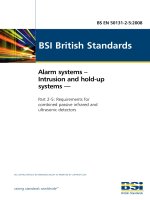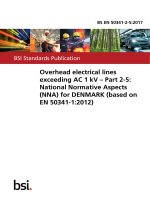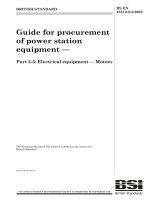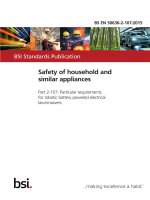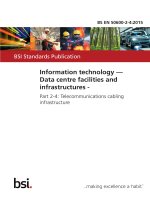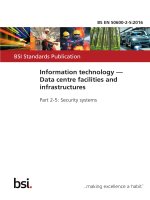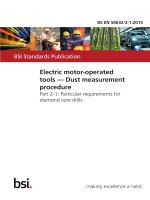Bsi bs en 61375 2 5 2015
Bạn đang xem bản rút gọn của tài liệu. Xem và tải ngay bản đầy đủ của tài liệu tại đây (3.81 MB, 128 trang )
BS EN 61375-2-5:2015
BSI Standards Publication
Electronic railway equipment —
Train communication network
(TCN)
Part 2-5: Ethernet train backbone
BS EN 61375-2-5:2015 BRITISH STANDARD
National foreword
This British Standard is the UK implementation of EN 61375-2-5:2015. It is
identical to IEC 61375-2-5:2014.
The UK participation in its preparation was entrusted by Technical
Committee GEL/9, Railway Electrotechnical Applications, to Panel
GEL/9/-/4, Railway applications - Train communication network and
multimedia systems.
A list of organizations represented on this committee can be obtained on
request to its secretary.
This publication does not purport to include all the necessary provisions of
a contract. Users are responsible for its correct application.
© The British Standards Institution 2015.
Published by BSI Standards Limited 2015
ISBN 978 0 580 72987 4
ICS 45.060
Compliance with a British Standard cannot confer immunity from
legal obligations.
This British Standard was published under the authority of the
Standards Policy and Strategy Committee on 31 March 2015.
Amendments/corrigenda issued since publication
Date Text affected
EUROPEAN STANDARD BS EN 61375-2-5:2015
NORME EUROPÉENNE
EUROPÄISCHE NORM EN 61375-2-5
ICS 45.060 February 2015
English Version
Electronic railway equipment - Train communication network
(TCN) - Part 2-5: Ethernet train backbone
(IEC 61375-2-5:2014)
Matériel électronique ferroviaire - Réseau embarqué de Elektronische Betriebsmittel für Bahnen - Zug-
train (TCN) - Partie 2-5: Réseau central de train Ethernet Kommunikations-Netzwerk - Teil 2-5: ETB - Ethernet Train
(IEC 61375-2-5:2014) Backbone
(IEC 61375-2-5:2014)
This European Standard was approved by CENELEC on 2014-09-29. CENELEC members are bound to comply with the CEN/CENELEC
Internal Regulations which stipulate the conditions for giving this European Standard the status of a national standard without any alteration.
Up-to-date lists and bibliographical references concerning such national standards may be obtained on application to the CEN-CENELEC
Management Centre or to any CENELEC member.
This European Standard exists in three official versions (English, French, German). A version in any other language made by translation
under the responsibility of a CENELEC member into its own language and notified to the CEN-CENELEC Management Centre has the
same status as the official versions.
CENELEC members are the national electrotechnical committees of Austria, Belgium, Bulgaria, Croatia, Cyprus, the Czech Republic,
Denmark, Estonia, Finland, Former Yugoslav Republic of Macedonia, France, Germany, Greece, Hungary, Iceland, Ireland, Italy, Latvia,
Lithuania, Luxembourg, Malta, the Netherlands, Norway, Poland, Portugal, Romania, Slovakia, Slovenia, Spain, Sweden, Switzerland,
Turkey and the United Kingdom.
European Committee for Electrotechnical Standardization
Comité Européen de Normalisation Electrotechnique
Europäisches Komitee für Elektrotechnische Normung
CEN-CENELEC Management Centre: Avenue Marnix 17, B-1000 Brussels
© 2015 CENELEC All rights of exploitation in any form and by any means reserved worldwide for CENELEC Members.
Ref. No. EN 61375-2-5:2015 E
BS EN 61375-2-5:2015
EN 61375-2-5:2015 - 2 -
Foreword
The text of document 9/1933/FDIS, future edition 1 of IEC 61375-2-5, prepared by IEC/TC 9 "Electrical
equipment and systems for railways" was submitted to the IEC-CENELEC parallel vote and approved by
CENELEC as EN 61375-2-5:2015.
The following dates are fixed:
• latest date by which the document has (dop) 2015-08-27
to be implemented at national level by (dow) 2017-09-29
publication of an identical national
standard or by endorsement
• latest date by which the national
standards conflicting with the
document have to be withdrawn
Attention is drawn to the possibility that some of the elements of this document may be the subject of
patent rights. CENELEC [and/or CEN] shall not be held responsible for identifying any or all such patent
rights.
Endorsement notice
The text of the International Standard IEC 61375-2-5:2014 was approved by CENELEC as a European
Standard without any modification.
IEC 61375-2-1:2012 NOTE Harmonized as EN 61375-2-1:2012.
IEC 61784-2 NOTE Harmonized as EN 61784-2.
IEC 61918 NOTE Harmonized as EN 61918.
BS EN 61375-2-5:2015
- 3 - EN 61375-2-5:2015
Annex ZA
(normative)
Normative references to international publications
with their corresponding European publications
The following documents, in whole or in part, are normatively referenced in this document and are
indispensable for its application. For dated references, only the edition cited applies. For undated
references, the latest edition of the referenced document (including any amendments) applies.
NOTE 1 When an International Publication has been modified by common modifications, indicated by (mod), the relevant EN/HD
applies.
NOTE 2 Up-to-date information on the latest versions of the European Standards listed in this annex is available here:
www.cenelec.eu.
Year Title EN/HD Year
Publication 2012 Connectors for electronic equipment - EN 61076-2-101 2012
IEC 61076-2-101 Product requirements -- Part 2-101: Circular
series connectors - Detail specification for M12 - series
IEC 61156 2007 connectors with screw-locking - -
IEC 61156-1 - Multicore and symmetrical pair/quad cables - -
for digital communications
IEC 61156-5 2012 Multicore and symmetrical pair/quad cables EN 61375-1 2012
- for digital communications - Part 1: Generic FprEN 61375-2-3 -
IEC 61375-1 - specification EN 61375-3-4 -
- Multicore and symmetrical pair/quad cables - -
IEC 61375-2-3 series for digital communications - Part 5: - series
series Symmetrical pair/quad cables with - series
IEC 61375-3-4 series transmission characteristics up to 1 000 EN ISO/IEC 9646 series
IEC 62236-3-2 2002 MHz - Horizontal floor wiring - Sectional - -
- specification - -
ISO/IEC 7498 2008 Electronic railway equipment - Train - -
communication network (TCN) -- Part 1:
ISO/IEC 8824 General architecture
ISO/IEC 9646 Electronic railway equipment - Train
ISO/IEC 11801 Communication Network (TCN) - Part 2-3:
IEEE 802.1AB TCN communication profile
Electronic railway equipment - Train Bus -
IEEE 802.1AX Part 3-4: ECN - Ethernet Consist Network
Railway applications - Electromagnetic
compatibility -- Part 3-2: Rolling stock -
Apparatus
Information processing systems - Open
systems interconnection - Basic reference
model
Information technology - Abstract Syntax
Notation One (ASN.1)
Information technology - Open Systems
Interconnection
Information technology - Generic cabling for
customer premises
IEEE Standard for Local and Metropolitan
Area Networks - Station and Media Access
Control Connectivity Discovery
IEEE Standard for Local and metropolitan
area networks - Link Aggregation
BS EN 61375-2-5:2015
EN 61375-2-5:2015 - 4 -
IEEE 802.1D 2012 IEEE Standard for local and metropolitan - -
area networks - Media Access Control
(MAC) Bridges
IEEE 802.1Q - IEEE Standard for Local and metropolitan - -
area networks - Media Access Control
(MAC) Bridges and Virtual Bridges
IEEE 802.2 - IEEE Standard for Information technology - - -
Telecommunications and information
exchange between systems - Local and
metropolitan area networks - Specific
requirements - Part 2: Logical Link Control
IEEE 802.3 2012 IEEE Standard for Ethernet - -
BS EN 61375-2-5:2015
- 5 - EN 61375-2-5:2015
Annex ZZ
(informative)
Relationship between this European Standard and the Essential
Requirements of EU Directive 2008/57/EC
This European Standard has been prepared under a mandate given to CENELEC by the European
Commission and the European Free Trade Association and within its scope the standard covers all
relevant essential requirements as given in Annex lll of the EC Directive 2008/57/EC (also named as
New Approach Directive 2008/57/EC Rail Systems: Interoperability).
Once this standard is cited in the Official Journal of the European Union under that Directive and has
been implemented as a national standard in at least one Member State, compliance with the
clauses of this standard given in Table ZZ.1 relating to the ‘rolling stock - locomotives and
passenger rolling stock’ subsystem of the rail system in the European Union, confers, within the
limits of the scope of this standard, a presumption of conformity with the corresponding Essential
Requirements of that Directive and associated EFTA regulations.
Table ZZ.1 - Correspondence between this European Standard, the RST LOC&PAS TSI
(published in the Official Journal L 356 on 12 December 2014, p. 228) and Directive
2008/57/EC
Clauses of this Chapter / § / points / Essential Comments
European Standard of RST LOC&PAS TSI Requirements (ER) of
Directive 2008/57/EC The TSI does not impose
The whole standard is 4.2.4.9 Brake state and 2. Requirements specific any technical solution
applicable fault indication to each sub-subsystem regarding physical
interfaces between units.
2.4. Rolling Stock
The standard offers a
4.2.5.2 Audible 2.4.1. Safety general multi-purpose
communication system solution for the inter-
2.4.2. Reliability vehicle digital
4.2.5.3 Passenger alarm and availability communication network
and it is relevant to
4.2.5.4 Communication 2.4.3. Technical vehicle interoperability.
devices for passengers compatibility
4.2.5.5 Exterior doors
4.2.12.2 General
documentation: -
description of
computerised onboard
systems
WARNING: Other requirements and other EU Directives may be applicable to the products
falling within the scope of this standard.
– 2 – BS EN 61375-2-5:2015
IEC 61375-2-5:2014 © IEC 2014
CONTENTS
INTRODUCTION ................................................................................................................... 9
1 Scope..........................................................................................................................10
2 Normative references...................................................................................................10
3 Terms, definitions, symbols, abbreviations and conventions .........................................11
3.1 Terms and definitions ..........................................................................................11
3.2 Symbols and abbreviations..................................................................................15
3.3 Conventions........................................................................................................17
3.3.1 Base of numeric values ................................................................................17
3.3.2 Naming conventions.....................................................................................17
3.3.3 State diagram conventions ...........................................................................17
3.3.4 Annotation of data structures........................................................................17
4 ETB physical layer.......................................................................................................17
4.1 Train regions.......................................................................................................17
4.2 Physical characteristics .......................................................................................18
4.2.1 General .......................................................................................................18
4.2.2 Intra car physical layer .................................................................................18
4.2.3 Inter car physical layer .................................................................................20
4.2.4 Inter Consist physical layer ..........................................................................24
4.3 Power over Ethernet (PoE) ..................................................................................27
4.4 ETB physical architecture and redundancy...........................................................29
4.4.1 General .......................................................................................................29
4.4.2 Link aggregation architecture .......................................................................29
4.4.3 Functions ..................................................................................................... 31
5 ETB data link layer ......................................................................................................32
6 ETB network layer: IPv4 subnets definition...................................................................33
6.1 General...............................................................................................................33
6.2 IP mapping introduction.......................................................................................34
6.3 Topology.............................................................................................................34
6.3.1 General .......................................................................................................34
6.3.2 Closed train .................................................................................................35
6.4 Network IP address map .....................................................................................36
6.4.1 Global IPv4 address space...........................................................................36
6.4.2 Train subnet definition..................................................................................36
6.4.3 Train IP address map summary ....................................................................40
6.4.4 Train IP group addresses (multicast) ............................................................41
6.5 Particular hosts IP addresses ..............................................................................41
6.5.1 ETBN (Ethernet Train Backbone Node).........................................................41
6.5.2 Hosts on train subnet ...................................................................................42
6.5.3 Host inside a closed train .............................................................................43
6.6 Some use cases..................................................................................................45
6.7 Dynamic IP routing management .........................................................................48
6.7.1 Unicast routes..............................................................................................48
6.7.2 Multicast routes ...........................................................................................48
7 ETB Transport layer.....................................................................................................49
8 ETB Train Inauguration: TTDP .....................................................................................50
BS EN 61375-2-5:2015 – 3 –
IEC 61375-2-5:2014 © IEC 2014
8.1 Contents of this clause ........................................................................................50
8.2 Objectives and assumptions ................................................................................50
8.2.1 Goals ........................................................................................................... 50
8.2.2 Out of scope ................................................................................................51
8.2.3 Assumptions ................................................................................................51
8.3 ETBN settings .....................................................................................................52
8.3.1 ETB switch port states .................................................................................52
8.3.2 Node settings...............................................................................................52
8.4 General behaviour...............................................................................................54
8.5 ETBN Inauguration state diagram ........................................................................54
8.5.1 General .......................................................................................................54
8.5.2 Actions ........................................................................................................55
8.5.3 Transitions ................................................................................................... 57
8.6 ETBN peers discovery .........................................................................................58
8.6.1 Internal peers detection................................................................................58
8.6.2 External peers detection...............................................................................58
8.6.3 Switch port states handling...........................................................................59
8.6.4 ETB lines statuses .......................................................................................59
8.7 TTDP messages description ................................................................................61
8.7.1 General .......................................................................................................61
8.7.2 Convention ..................................................................................................61
8.7.3 TTDP frame tagging .....................................................................................61
8.7.4 Transport and addressing.............................................................................61
8.7.5 TTDP HELLO frame .....................................................................................62
8.7.6 TTDP TOPOLOGY frame .............................................................................66
8.8 TTDP data structures ..........................................................................................72
8.8.1 Connectivity Vector ......................................................................................72
8.8.2 ETBN Vector................................................................................................73
8.8.3 Connectivity Table .......................................................................................73
8.8.4 Connectivity Table CRC ...............................................................................74
8.8.5 Train network directory.................................................................................76
8.8.6 Train network directory CRC (Topology Counter) ..........................................78
8.8.7 Corrected topology.......................................................................................78
8.9 TTDP frames timing ............................................................................................79
8.9.1 TTDP HELLO ...............................................................................................79
8.9.2 TTDP TOPOLOGY .......................................................................................81
8.10 Inauguration Train Application interface ...............................................................83
8.11 Degraded modes.................................................................................................83
8.11.1 Late insertion ETBN .....................................................................................83
8.11.2 Losing ETBN................................................................................................84
8.11.3 End ETBN failure and partial topology counter ..............................................84
8.12 Some discovery timing ........................................................................................85
8.12.1 ETBN wakeup ..............................................................................................85
8.12.2 ETBN failure ................................................................................................86
8.12.3 Consist coupling ..........................................................................................87
9 ETB ETBN redundancy ................................................................................................88
10 ETB physical train naming convention (optional)...........................................................89
10.1 General...............................................................................................................89
10.2 ETB Train domain ...............................................................................................89
– 4 – BS EN 61375-2-5:2015
IEC 61375-2-5:2014 © IEC 2014
10.3 Hostname ...........................................................................................................90
11 ETB Quality of Service.................................................................................................91
11.1 Contents of this clause ........................................................................................91
11.2 Frame forwarding ................................................................................................91
11.2.1 ETBN switching rate.....................................................................................91
11.2.2 No Head-of-Line blocking .............................................................................91
11.2.3 Switching priorities.......................................................................................91
11.2.4 Switching queuing scheme ...........................................................................92
11.3 Priority of Inauguration frames.............................................................................92
11.4 ETB ingress rate limiting .....................................................................................92
11.5 ETB egress rate shaping .....................................................................................92
11.6 ETB data classes ................................................................................................92
12 ETB Management and monitoring ................................................................................93
13 ETB Application interface.............................................................................................93
13.1 Contents of this clause ........................................................................................93
13.2 Abstract communication model ............................................................................93
13.3 ETB Process Data and Message Data protocols ..................................................94
13.4 ETB protocol transparency ..................................................................................94
13.5 ETBN interfaces ..................................................................................................94
13.5.1 Application...................................................................................................94
13.5.2 Maintenance and monitoring.........................................................................95
14 ETB conformity statement ............................................................................................96
Annex A (normative) Summary of ETB sizing parameters....................................................97
Annex B (normative) Physical topology building algorithm...................................................98
Annex C (normative) TTDP MIB definition ........................................................................101
Bibliography ..................................................................................................................... 121
Figure 1 – ETB train regions ...............................................................................................18
Figure 2 – ETB Inter car at same potential...........................................................................23
Figure 3 – ETB Inter car not at the same potential ...............................................................24
Figure 4 – ETB Consist reversing ........................................................................................26
Figure 5 – ETB Inter Consist segment .................................................................................27
Figure 6 – ETBN PSE PoE use case ...................................................................................27
Figure 7 – ETBN PD PoE use case .....................................................................................28
Figure 8 – PoE in inter-Consist............................................................................................28
Figure 9 – PoE PSE alternative A........................................................................................29
Figure 10 – Redundant train backbone architecture .............................................................29
Figure 11 – Link aggregation model ....................................................................................30
Figure 12 – Link aggregation group .....................................................................................31
Figure 13 – Conversations over LAG ...................................................................................31
Figure 14 – Hierarchical Consist topology............................................................................35
Figure 15 – Closed train......................................................................................................36
Figure 16 – "Subnet Id" with single Consist Network ............................................................38
Figure 17 – "Subnet Id" with two single Consist Networks ....................................................38
Figure 18 – Multiple Consist Networks, without fault tolerance .............................................39
BS EN 61375-2-5:2015 – 5 –
IEC 61375-2-5:2014 © IEC 2014
Figure 19 – "Subnet Id" with ETBN redundancy ...................................................................39
Figure 20 – "Subnet Id" in multiple units with ETBN redundancy ..........................................40
Figure 21 – IP train address space summary .......................................................................40
Figure 22 – Relative addressing example ............................................................................45
Figure 23 – Train composed of a single Consist Network .....................................................46
Figure 24 – Train composed of two single Consist Networks ................................................46
Figure 25 – Train composed of single Consist Network with ETBN redundancy ....................47
Figure 26 – Train composed of two Consist Networks with ETBN redundancy ......................47
Figure 27 – Train with two Consist Networks in single Consist .............................................48
Figure 28 – ETBN top node reference .................................................................................51
Figure 29 – ETBN orientation capability...............................................................................52
Figure 30 – ETB switch in passive bypass setting ................................................................53
Figure 31 – ETB switch in intermediate setting ....................................................................53
Figure 32 – ETB switch in End Node Setting........................................................................54
Figure 33 – ETBN Inauguration state diagram .....................................................................55
Figure 34 – Switch port state diagram .................................................................................59
Figure 35 – ETBN physical line state machine .....................................................................60
Figure 36 – TTDP HELLO frame LLDPDU structure .............................................................62
Figure 37 – LLDP organizationally TLV structure .................................................................62
Figure 38 – TTDP HELLO frame structure ...........................................................................66
Figure 39 – TTDP specific HELLO TLV structure .................................................................66
Figure 40 – TTDP TOPOLOGY frame structure....................................................................71
Figure 41 – TTDP TOPOLOGY specific ETB TLV structure ..................................................72
Figure 42 – TTDP TOPOLOGY specific CN TLV structure....................................................72
Figure 43 – Train composition for TNDir example ................................................................77
Figure 44 – TTDP HELLO normal mode and recovery timing................................................80
Figure 45 – TTDP HELLO failure timing...............................................................................81
Figure 46 – TTDP TOPOLOGY frames handling ..................................................................82
Figure 47 – TTDP ETBNs wake up timing ............................................................................85
Figure 48 – TTDP ETBN failure timing.................................................................................86
Figure 49 – TTDP Consist coupling timing ...........................................................................87
Figure 50 – Example of ETBN IP routing table without redundancy ......................................88
Figure 51 – Example of ETBN IP routing table with redundancy ...........................................88
Figure 52 – ETB train domain defintion................................................................................90
Figure 53 – Abstract communication model for ETB communication .....................................94
Figure B.1 – Physical topology building ...............................................................................98
Figure C.1 – TTDP MIB tree view ...................................................................................... 103
Table 1 – ETB Intra car physical layer interface ...................................................................19
Table 2 – ETB Inter car physical layer interface ...................................................................21
Table 3 – ETB Inter consist physical layer interface .............................................................25
Table 4 – ETB Switch data link layer interface .....................................................................32
Table 5 – ETB OSI Network layer ........................................................................................33
– 6 – BS EN 61375-2-5:2015
IEC 61375-2-5:2014 © IEC 2014
Table 6 – Train subnet definition .........................................................................................36
Table 7 – Train subnet decomposition .................................................................................37
Table 8 – Train IP group addresses reserved range.............................................................41
Table 9 – ETBN ETB IP address .........................................................................................42
Table 10 – Hosts IP on train subnet.....................................................................................43
Table 11 – Application ED common interface.......................................................................50
Table 12 – ETB switch port states .......................................................................................52
Table 13 – TTDP destination MAC addresses ......................................................................62
Table 14 – Connectivity Vector............................................................................................73
Table 15 – Connectivity Vector Fields .................................................................................73
Table 16 – ETBN Vector .....................................................................................................73
Table 17 – ETBN Vector Fields ...........................................................................................73
Table 18 – Connectivity Table .............................................................................................74
Table 19 – Connectivity Table fields ....................................................................................74
Table 20 – Train network directory ......................................................................................76
Table 21 – Train network directory fields .............................................................................76
Table 22 – Train network directory (example) ......................................................................78
Table 23 – DSCP field mapping...........................................................................................91
Table 24 – ETB Switching Priorities.....................................................................................92
Table 25 – Train Topology Discovery Object........................................................................95
Table A.1 – ETB sizing parameters .....................................................................................97
BS EN 61375-2-5:2015 – 9 –
IEC 61375-2-5:2014 © IEC 2014
INTRODUCTION
IEC 61375-2-5 defines the Ethernet Train Backbone so as to achieve interoperability between
Consists of different types when coupled in the same train composition.
The standard follows the ISO-OSI model and specifies the whole protocols stack from the
physical layer up to the application layer.
A Protocol Implementation Conformance Statement (PICS) pro-forma allows suppliers to state
their conformity to this standard. The PICS pro-forma specification and the related conformity
test are not in the scope of this standard.
– 10 – BS EN 61375-2-5:2015
IEC 61375-2-5:2014 © IEC 2014
ELECTRONIC RAILWAY EQUIPMENT –
TRAIN COMMUNICATION NETWORK (TCN) –
Part 2-5: Ethernet train backbone
1 Scope
This part of IEC 61375 defines Ethernet Train Backbone (ETB) requirements to fulfil open
train data communication system based on Ethernet technology.
Respect of this standard ensures interoperability between local Consist subnets whatever
Consist network technology (see IEC 61375-1 for more details).
All Consist network definitions should take into account this standard to preserve
interoperability.
This standard may be additionally applicable to closed trains and multiple-unit trains when so
agreed between purchaser and supplier.
2 Normative references
The following documents, in whole or in part, are normatively referenced in this document and
are indispensable for its application. For dated references, only the edition cited applies. For
undated references, the latest edition of the referenced document (including any
amendments) applies.
IEC 61076-2-101:2012, Connectors for electronic equipment – Product requirements –
Part 2-101: Circular connectors – Detail specification for M12 connectors with screw-locking
IEC 61156 (all parts), Multicore and symmetrical pair/quad cables for digital communications
IEC 61156-1:2007, Multicore and symmetrical pair/quad cables for digital communications –
Part 1: Generic specification
IEC 61156-5, Multicore and symmetrical pair/quad cables for digital communications – Part 5:
Symmetrical pair/quad cables with transmission characteristics up to 1 000 MHz – Horizontal
floor wiring – Sectional specification
IEC 61375-1:2012, Electronic railway equipment – Train communication network (TCN) –
Part 1: General architecture
IEC 61375-2-3, Electronic railway equipment – Train communication network (TCN) –
Part 2-3: TCN communication profile (to be published)
IEC 61375-3-4, Electronic railway equipment – Train communication network (TCN) –
Part 3-4: Ethernet Consist Network (ECN)
IEC 62236-3-2, Railway applications – Electromagnetic compatibility – Part 3-2: Rolling stock
– Apparatus
ISO/IEC 7498 (all parts), Information technology – Open System Interconnection – Basic
Reference Model
BS EN 61375-2-5:2015 – 11 –
IEC 61375-2-5:2014 © IEC 2014
ISO/IEC 8824 (all parts), Information technology – Abstract Syntax Notation One (ASN.1)
ISO/IEC 9646 (all parts), Information technology – Open Systems Interconnection –
Conformance testing methodology and framework
ISO/IEC 11801:2002, Information technology – Generic cabling for customer premises
IEEE 802.1AB, IEEE Standard for Local and metropolitan area networks – Station and Media
Access Control Connectivity Discovery
IEEE 802.1AX:2008, IEEE Standard for Local and metropolitan area networks – Link
Aggregation
IEEE 802.1D:2012, IEEE Standard for Local and metropolitan area networks – Media Access
Control (MAC) Bridges
IEEE 802.1Q, IEEE Standard for Local and metropolitan area networks – Virtual Bridged
Local Area Networks
IEEE 802.2, IEEE Standard for Information technology – Telecommunications and information
exchange between systems – Local and metropolitan area networks – Specific requirements –
Part 2: Logical Link Control
IEEE 802.3:2012, IEEE Standard for Information technology – Telecommunications and
information exchange between systems – Local and metropolitan area networks – Specific
requirements – Part 3: Carrier sense multiple access with collision detection (CSMA/CD)
access method and physical layer specifications
3 Terms, definitions, symbols, abbreviations and conventions
3.1 Terms and definitions
For the purposes of this document, the following terms and definitions apply.
3.1.1
application layer
upper layer in the OSI model, interfacing directly to the Application
3.1.2
application process
element within a real open system which performs the information processing for a particular
application
3.1.3
bridge
device which stores and forwards frames from one bus to another on the base of their Link
Layer addresses
3.1.4
broadcast
nearly simultaneous transmission of the same information to several destinations
Note 1 to entry: Broadcast in the TCN is not considered reliable, i.e. some destinations may receive the
information and others not.
– 12 – BS EN 61375-2-5:2015
IEC 61375-2-5:2014 © IEC 2014
3.1.5
bus
communication medium which broadcasts the same information to all attached participants at
nearly the same time, allowing all devices to obtain the same sight of its state, at least for the
purpose of arbitration
3.1.6
closed train
train composed of one or a set of Consists, where the configuration does not change during
normal operation, for instance metro, sub-urban train, or high speed train units
3.1.7
communication devices
devices connected to Consist Network or Train Backbone with the ability to source and sink
data
3.1.8
composition
number and characteristics of the vehicles forming a train
3.1.9
configuration
definition of the topology of a network, the devices connected to it, their capabilities and the
traffic they produce; by extension, the operation of loading the devices with the configuration
information before going to regular operation
3.1.10
consist
train set
rake of coaches
single vehicle or a group of vehicles which are not separated during normal operation. A
Consist contains no, one or several Consist networks.
3.1.11
Consist Network
CN
communication network interconnecting communication devices in one Consist
3.1.12
End Device
ED
unit connected to one Consist Network or to one set of Consist Networks prepared for
redundancy reasons
3.1.13
end node
node which terminates the Train Backbone
3.1.14
function
Application Process which exchanges messages with another Application Process
3.1.15
gateway
connection between different communication technologies
BS EN 61375-2-5:2015 – 13 –
IEC 61375-2-5:2014 © IEC 2014
3.1.16
group address
address of a multicast group to which a device belongs
3.1.17
host
any addressable unit connected to the network: End Devices, Network Devices, etc.
3.1.18 composition change, which gives all Nodes of the Train
inauguration address, their orientation and information about all named
operation executed in case of
Backbone their Train Backbone
Nodes on the same backbone
3.1.19
integrity
property of a system to recognize and to reject wrong data in case of malfunction of its parts
3.1.20
intermediate node
node which establishes continuity between two bus sections connected to it, but does not
terminate them
3.1.21
linear topology
topology where the nodes are connected in series, with two nodes each connected to only
one other node and all others each connected to two other nodes (that is, connected in the
shape of a line)
3.1.22
Local Area Network
part of a network characterized by a common medium access and address space
3.1.23
Medium Access Control
sublayer of the Link Layer, which controls the access to the medium (arbitration, mastership
transfer, polling)
3.1.24
medium
physical carrier of the signal: electrical wires, optical fibers, etc.
3.1.25
message
data item transmitted in one or several packets
3.1.26
Mobile Train Unit
part of a train which shall be uniquely addressable from ground. A mobile train unit provides
one active mobile communication gateway for train to ground communication.
3.1.27
multicast
transmission of the same message to a group of receivers, identified by their Group Address
Note 1 to entry: The word "multicast" is used even if the group includes all receivers.
– 14 – BS EN 61375-2-5:2015
IEC 61375-2-5:2014 © IEC 2014
3.1.28
network
set of possibly different communication systems which interchange information in a commonly
agreed way
3.1.29
network address
address which identifies a communication device on network layer
3.1.30
network device
ND
components used to set up Consist Networks and Train Networks
Note 1 to entry: These may be passive components such as cables or connectors, active unmanaged components
such as repeaters, media converters or (unmanaged) switches, or active managed components such as
gateways, routers and (managed) switches.
3.1.31
network layer
layer in the OSI model responsible for routing between different busses
3.1.32
network management
operations necessary to remotely configure, monitor, diagnose and maintain the network
3.1.33
node
device on the Train Backbone, which may act as a gateway between Train Backbone and
Consist Network
3.1.34
open train
train composed of a set of Consists, where the configuration may change during operation, for
instance international trains
3.1.35
operator
enterprise or organization which operates trains
3.1.36
packet
unit of a message (information, acknowledgement or control) transmitted by protocols on
network or transport layer
3.1.37
receiver
electronic device which may receive signals from the physical medium
3.1.38
repeater
connection at the Physical Layer between bus segments, providing an extension of the bus
beyond the limits permitted by passive means
Note 1 to entry: The connected segments operate at the same speed and with the same protocol. The delay
introduced by a repeater is in the order of one bit duration.
BS EN 61375-2-5:2015 – 15 –
IEC 61375-2-5:2014 © IEC 2014
3.1.39
router
connection between two busses at the Network Layer, which forwards datagrams from one
bus to another on the base of their Network Address
3.1.40
service
capabilities and features of a sub-system (e.g. a communication layer) provided to a user
3.1.41
switch
MAC bridge as defined in IEEE 802.1D
3.1.42
topology
possible cable interconnection and number of devices a given network supports
3.1.43
topology counter
counter in a node which at each Inauguration memorises CRC of Train Network Directory
3.1.44
train communication network
data communication network for connecting programmable electronic equipment on-board rail
vehicles
3.1.45
train backbone
bus connecting the vehicles of a train and which conforms to the TCN protocols
3.1.46
train backbone node
node device on the Train Backbone which receives a train backbone node number during
Inauguration. A train backbone node can be used to connect an End Device or a Consist
Network to the Train Backbone.
3.1.47 is assigned a number during Inauguration, which indicates
train backbone node number node on the Train Backbone
node address
node number
each active train backbone node
the position of the train backbone
3.1.48
transport layer
layer of the OSI model responsible for end-to-end flow control and error recovery
3.2 Symbols and abbreviations
CAN Controller Area Network
CCTV Closed Circuit Television
CIDR Classless Inter Domain Routing
CN Consist Network
CRC Cyclic Redundancy Check
CSTINFO ConSisT INFOrmation
CstUUID Consist Universally Unique IDentifier
– 16 – BS EN 61375-2-5:2015
IEC 61375-2-5:2014 © IEC 2014
DHCP Dynamic Host Configuration Protocol
DNS Domain Name System
ECN Ethernet Consist Network
ED End Device
EMC Electro Magnetic Compatibility
ETB Ethernet Train Backbone
ETBN Ethernet Train Backbone Node
FLR Frame Loss Rate
FQDN Fully Qualified Domain Name
IEEE Institute of Electrical and Electronics Engineers
IETF Internet Engineering Task Force
IP Internet Protocol
LACP Link Aggregation Control Protocol
LAG Link Aggregation Group
LLDP Link Layer Discovery Protocol
LLDPDU LLDP Data Unit
MAC Medium Access Control
MCG Mobile Communication Gateway
MDI Media Dependent Interface
MTU Maximum Transmission Unit
MVB Multifunction Vehicle Bus
NAT Network Address Translation
ND Network Device
NTP Network Time Protocol
OSI Open System Interconnection
PCS Physical Coding Sublayer
PD Powered Device (about PoE)
PD/MD Process Data/Message Data
PICS Protocol Implementation Conformance Statement
PMA Physical Medium Attachment
PMD Physical Medium Dependent
PoE Power Over Ethernet
PSE Power Source Equipment (about PoE)
RFC Request For Comments
TBN Train Backbone Node
TCMS Train Control and Monitoring System
TCN Train Communication Network
TCP Transport Control Protocol
TLV Type/Length/Value
TNDir Train Network Directory
TTDP Train Topology Discovery Protocol
UDP User Data protocol
UML Unified Modeling Language
